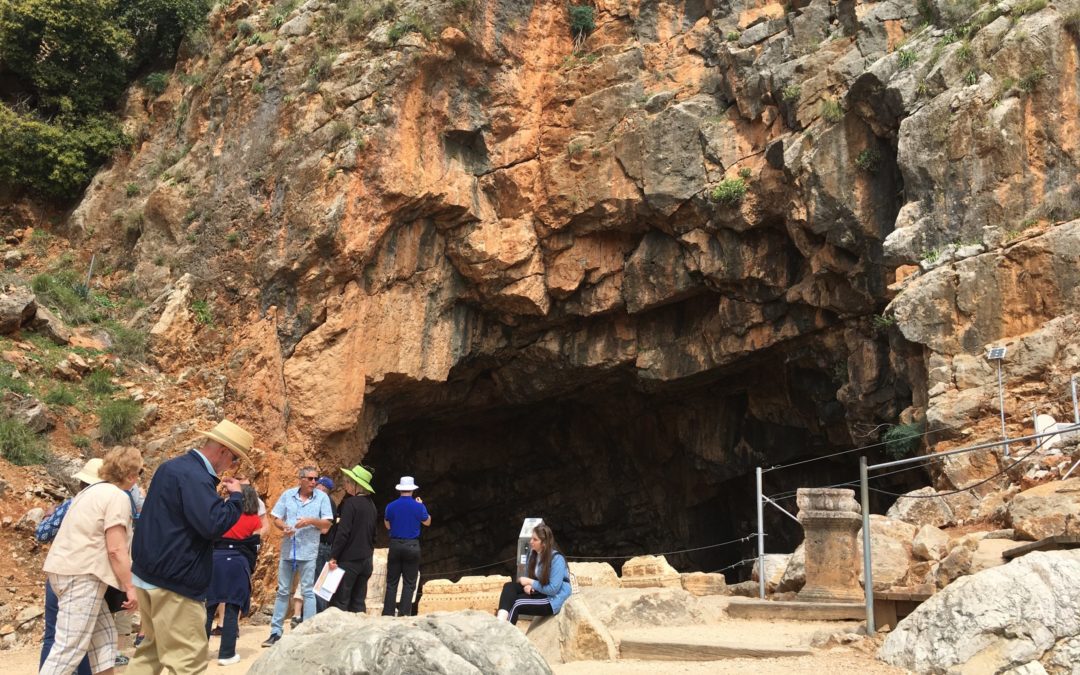
This cave was once believed to be the entrance to Hades. Near this cave, Jesus asked Peter: “Who do you say I am?” (Photo by Doug Peterson)
We had just stepped off of the bus at the Dan archaeological site in northern Israel when our guide told us to quickly turn around. So our tour group hustled back onto the bus because there had been an incident very close to this site at the border between Israel and Lebanon.
When you’re in Israel, the last thing you want to hear about is a border incident.
We didn’t hear explosions or gunfire, however. We simply obeyed, hopped back on the bus, and headed to our next site—Caesarea Philippi, also in northern Israel.
The northern portion of the country, which includes the Golan Heights, is a point of confrontation between Israel and both Lebanon and Syria. Even in Jesus’s day, this part of Israel was a place of confrontation, where spiritual forces clashed, as I was soon to learn when we drove to Caesarea Philippi.
After we arrived, we hiked up to a massive cliff, with huge boulders scattered all about. Tufts of vegetation stuck from the rocks, which were orange in color with streaks of black running through them. In the midst of the stonework was a huge, yawning cave, like an enormous mouth.
Back in Jesus’s day, people believed this cave was the entrance to Hades—the underworld where people journeyed after they died. It was also the place where Jesus chose to ask the most important question in life: “Who do you say I am?†He asked this of His disciples, but it’s a question that every single one of us must answer during our life.
Caesarea Philippi is about 25 miles north of the Sea of Galilee, and in the first century it was pagan territory. Not only was the cave thought to be a doorway into Hades, but this grotto was where people worshipped Pan, the god of nature and mountain wilds. Pan was believed to have the legs of a goat and the torso and head of a human.
Jesus didn’t shy away from confrontation, so I don’t think it was coincidence that he chose to ask this important question in the heart of pagan territory.
“Who do you say I am?†He asks in chapter 16 of the Book of Matthew.
At first, the disciples answer by simply repeating what others have said about Him. They point out that some say Jesus is John the Baptist or Elijah or Jeremiah. But Jesus presses them, asking who they think He is.
Leave it to Peter to be the bold one. “You are the Messiah, the Son of the Living God,†he blurts out in Matthew 16:16.
Jesus is pleased with this response, and He tells Peter, “On this rock I will build my church, and the gates of Hades will not overcome it.â€
When I stood in front of that ominous cave, which pagans believed led directly into Hades, Jesus’s words suddenly came alive. The gates of Hades will not overcome the church.
But Peter is a fascinating man. One moment, he is doing astounding things, and the next moment he’s messing up big time. When Jesus goes on to explain that the Messiah must die, Peter shouts, “Never, Lord! This shall never happen to you!â€
Then Jesus wheels around and exclaims to Peter, “Get behind me, Satan! You are a stumbling block to me; you do not have in mind the concerns of God.â€
 One moment, Peter is the “rock†on which the church will be built. And the next moment Jesus is calling him a “stumbling block.†But why such anger? And why would Jesus call Peter “Satan†of all things?
One moment, Peter is the “rock†on which the church will be built. And the next moment Jesus is calling him a “stumbling block.†But why such anger? And why would Jesus call Peter “Satan†of all things?
There’s a good reason. In the desert, Satan tempted Jesus by telling Him that He didn’t need to die. The devil said that if our Lord would fall down and worship him, he would make sure that Jesus ruled all of the kingdoms of the world. He could be a king without the cross.
In his ignorance, Peter was saying essentially the same thing—that Jesus didn’t need to die. But our Lord knew full well that His road went through Calvary, and as I said, He did not avoid confrontations. He faced evil and death head on.
That is why Jesus asked the most important question of all in the heart of darkness, before the Temple of Pan. “Who do you say I am?â€
We all live in a world surrounded by temptations. We all face caves filled with darkness. But in the midst of this darkness, Jesus asks all of us the same question.
Don’t turn away from this question. Face it head on. He’s waiting for your answer.
By Doug Peterson
